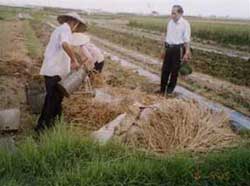Utilizing Biological Products to Transform Straw into Fertilizer
Experts from the Institute of Biotechnology have assisted farmers in converting straw into a valuable soil amendment. This method not only improves soil quality but also contributes to environmental protection.
 |
|
Processing Straw into Fertilizer |
After each harvest, scattered across several fields in five districts of Nam Dinh Province are piles of straw covered with white plastic or mud. These are not ordinary straw piles; they have been treated with a biological product. With this treatment, after 17-25 days, the straw decomposes and turns into an excellent fertilizer for fields. When applied before planting, this fertilizer can reduce chemical fertilizer use by 20-30% while increasing crop yields by 5-7%.
The project, funded by the Nam Dinh Department of Science and Technology, began in late 2004 and has successfully been implemented over 75 hectares each season in the districts of Xuan Truong, Nam Truc, Y Yen, Vu Ban, and My Loc. According to Dr. Tran Dinh Man, Deputy Director of the Institute of Biotechnology, the project not only helps farmers maintain soil fertility but also addresses the pressing issue of environmental pollution.
If scaled up, the emergence of these straw piles would also mean the end of smoke and dust caused by burning straw in the fields. The indiscriminate disposal of straw in canals, due to the excess of straw, would also significantly decrease.
To convert straw into fertilizer, the research team led by Associate Professor Dr. Ly Kim Bang utilized a biological product developed by the Institute of Biotechnology. This powdered product contains 12-15 types of microorganisms isolated in Vietnam, including Bacillus strains and actinomycetes capable of producing various enzymes to decompose organic matter in waste and straw. Additionally, some functional microorganisms, such as those antagonistic to certain plant diseases, nitrogen-fixing bacteria, and microorganisms that decompose insoluble phosphates, help plants absorb nutrients more easily.
After harvesting, farmers collect the straw in the corners of their fields, mix the biological product with water and NPK fertilizer, and then apply it to the straw. They cover the straw with standard plastic to retain moisture or apply mud. For every kilogram of product, one kilogram of NPK is needed for application to straw in one sao (a Vietnamese unit of area). One ton of straw requires about 5-10 kilograms of the product, depending on how quickly the farmers want the straw to decompose. The price of the product ranges from 13,000 to 15,000 VND per kilogram.
Dr. Man noted that the project provides all the products, supports plastic covering, pays for straw collection labor for farmers, and offers technical training. However, as farmers began to see the benefits of this practice, many started inquiring about purchasing the product. Currently, the technology for converting straw into fertilizer has been refined, and the product is preparing for commercialization. At the conclusion of the project, the Institute of Biotechnology plans to transfer production technology to Nam Dinh and expand the processing technology to the southern regions, where there is a significant amount of straw left after each harvest.

















































